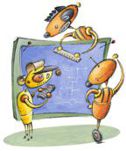Date: August 28, 1996
Speaker: David Nagle, CMU
A Case for Network-attached Storage
Abstract:
The tremendous growth in network-accessible digital information, driven by digital media and the Web, has greatly increased the importance of storage system architecture in mainstream computing. Unfortunately, current networked disk storage systems are limited by an inefficient data management system architecture. The NASD team's research into Network-attached storage seeks to eliminates many of the current bottlenecks by providing direct data transfer between storage and client.
Realizing Network-attached storage's full potential requires careful consideration across a wide range of file system, networking and security issues. This talk will highlight the NASD teams recent work in these areas. Three architectural models of network-attached storage, (1) Server-attached Disks (SAD), (2) Networked SCSI disks (NetSCSI), and (3) Network-attached secure disks (NASD), will be used to present a sketch of repartitionings of distributed file system functionality, including a security framework whose strongest levels use tamper-resistant processing in the disks to provide action authorization and data privacy even when the drive is in an physically insecure location. This will lead into a discussion of the file system, networking and performance issues and our AFS and NFS performance measurements that evaluate each architecture's potential decrease to file server work-load. The results suggest that NetSCSI can reduce file server load during a burst of AFS activity by a factor of about 2; for the NASD architecture, server load (during burst activity) can be reduced by a factor of about 4 for AFS and 10 for NFS.
SDI / LCS Seminar Questions?
Karen Lindenfelser, 86716, or visit www.pdl.cmu.edu/SDI/
